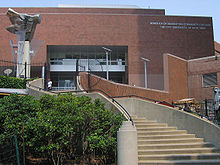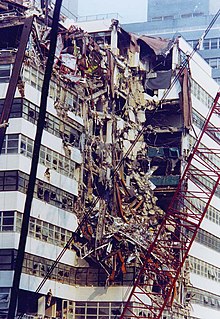Borough of Manhattan Community College
President Anthony E. Munroe[1] | | |
| Students | 26,831 | |
|---|---|---|
| Location | , , U.S. | |
| Campus | Urban | |
| Website | www | |
The Borough of Manhattan Community College (BMCC) is a
BMCC's original campus was scattered all over midtown Manhattan, utilizing office spaces, hotel conference rooms, and various spaces throughout Manhattan. In the mid-1970s, CUNY began scouting for suitable property on which to erect a new campus of its own. The current campus has been in use since 1983.
History
Martin B. Dworkis was BMCC's first president.[2] Classes were originally held in part of the ground floor, the entire second floor, and part of the third floor of an office building at 131 West 50th Street in midtown Manhattan. BMCC renovated the office space into classrooms and administrative areas, and it created its own entrance at 134 West 51st Street.[3] Fred Kelly, a graphic designer living in of Kew Gardens, designed BMCC's official seal.[4] BMCC's first classes were held in fall 1964.[5] During its first school year, 42 percent of its students were African American.[6]
Plans were announced for BMCC to have its own buildings to hold its classes in 1968. In 1974, the
On the morning of September 11, 2001, BMCC's students, teachers, and staff members heard explosions coming from the direction of the World Trade Center, which was located just a few blocks away. Port Authority of New York and New Jersey used the gymnasium at BMCC's main building to triage survivors, and BMCC donated medical supplies from BMCC's Nursing Department to treat victims. The Port Authority set up generators at BMCC's main building, and the building became its command center. That afternoon, 7 World Trade Center, across the street from BMCC's Fiterman Hall, collapsed, and the building fell onto Fiterman Hall, rendering the hall uninhabitable.[11][12] BMCC's staff worked constantly to restore Fiterman Hall and, on October 1, the building reopened for classes.[13][14] The hall was eventually demolished and a new building opened in September 2012.[15]
Academics
BMCC has also recorded a large rise in remedial education,[16] lack of freshman retention,[17] and overcrowding. Due to its larger base of capital compared to most other two-year colleges, expansion of new campuses during the rebuilding of Fiterman Hall was possible. Several trailers are still used as classrooms to help expand capacity. Internal programs have also been created or expanded to help with academic advisement, provide online access for registration, transferring to other colleges, and job placement.
BMCC also has a diverse student base,[18] some of whom had immigrated to America shortly before enrolling.[19] Among other issues are improving the retention and graduation rate, as well as the increased financial and academic burdens of a remedial program.
Campus

Borough of Manhattan Community College's four main campuses are in the
Downtown/Tribeca campus
- 199 Chambers Street, New York, NY 10008 – Main Campus
- 245 Greenwich Street (North entrance), 81 Barclay Street (South entrance); New York, NY 10007 – Fiterman Hall
- 70 Murray Street, New York, NY 10008 – Chambers Street
Fiterman Hall

The original Fiterman Hall opened in 1959 and occupied a block bounded by Greenwich Street, Barclay Street, West Broadway, and Park Place.[21] It had been the original location of King's College, before it was renamed Columbia University and moved to Morningside Heights.[22][23] Fiterman Hall was donated to BMCC in 1993 by Miles and Shirley Fiterman, for whom the building was subsequently named.[10][24] The building had previously been used as a bank, and CUNY had wanted to rent the building from the Fitermans, but they decided to donate the building to CUNY instead. It was the largest gift of a building to a community college in the United States, and it was the largest donation ever to CUNY. The building was renamed Miles and Shirley Fiterman Hall.[25] In 2000, the Dormitory Authority of the State of New York, which owned the building, began a massive renovation to better adapt the building for classroom use.[26]
During the September 11 attacks, the building's structure was heavily compromised by debris from the collapse of 7 World Trade Center, and the renovation was never completed. The building became unsafe to occupy because of exposed asbestos and mold growth. Since traditional demolition would result in an unacceptable environmental impact, the building was scheduled for deconstruction and decontamination as a part of the Lower Manhattan redevelopment project.[27]

Fiterman Hall was to be replaced by a new building designed by the architectural firm Pei Cobb Freed & Partners[28] after the deconstruction, and was scheduled to be completed by February 2007.[29][30] However, environmental impact concerns and funding issues caused numerous delays. At a press conference at BMCC on November 13, 2008, city and state officials announced a new agreement that revised demolition and reconstruction plans through a funding agreement among New York City, New York State, and the City University of New York. In addition, approximately $80 million from an insurance settlement would be applied to the project's budget.[31] Under the plan, the building was demolished and rebuilt in November 2009,[32] and the new Fiterman Hall was completed in September 2012.[15][26][33]
Off-site programs
- Brooklyn College
- CUNY in the Heights
- John Jay College
- Lehman College
- Long Island University Brooklyn
- St. John's University Manhattan
Athletics
College teams of the BMCC participate as a member of the National Junior College Athletic Association (NJCAA). The Panthers are a member of the community college section of the City University of New York Athletic Conference (CUNYAC). Men's sports include baseball, basketball, soccer and swimming; while women's sports include basketball, soccer, swimming and volleyball.[citation needed]

BMCC offers a large state-of-the-art recreation facility including a regulation basketball court,
Notable alumni
- Cardi B, rapper, songwriter, and reality television personality[35]
- Kid Chaos, musician[36]
- Queen Latifah, singer-songwriter, rapper, actress, and producer[37]
- Saul Rogovin, professional baseball player
- Mirko Savone, voice-over actor
- Gabourey Sidibe, actress
- Adam Saleh, YouTuber and boxer
- Michael K. Williams, actor
References
- ^ "CUNY Names Four College Presidents". CUNY Newswire (Press release). June 29, 2020. Retrieved November 25, 2020.
- ISSN 0362-4331. Retrieved February 12, 2020.
- ISSN 0362-4331. Retrieved February 12, 2020.
- ISSN 0362-4331. Retrieved February 12, 2020.
- ISSN 0362-4331. Retrieved February 12, 2020.
- ^ Hicks, James L. (December 5, 1964). "Change In Plans". New York Amsterdam News. p. 11.
- ^ ISSN 0362-4331. Retrieved February 12, 2020.
- ISSN 0362-4331. Retrieved February 12, 2020.
- ISSN 0362-4331. Retrieved February 13, 2020.
- ^ a b "BMCC receives record cash gift". New York Daily News. Associated Press. April 30, 2007. Retrieved May 30, 2017.
- ISSN 0362-4331. Retrieved February 12, 2020.
- ^ Josephsen, Kelly (September 29, 2001). "HCC lends a hand: Tragedy hurt NYC school". Pantagraph. Bloomington, Illinois. p. A3. Retrieved February 12, 2020 – via newspapers.com
 .
.
- ^ Garin, Kristoffer A. (October 2, 2001). "'Weird' Going Back to College Near WTC". New York Daily News. p. 28. Retrieved February 12, 2020 – via ProQuest.
- ISSN 0362-4331. Retrieved February 12, 2020.
- ^ ISSN 0099-9660. Retrieved February 12, 2020.
- ISSN 0362-4331. Retrieved February 12, 2020.
- ^ Changing Culture: A New Program for Liberal Arts Advisement at an Urban Community College
- ISSN 0362-4331. Retrieved February 12, 2020.
- ^ 'START HERE. GO ANYWHERE', NOT JUST BOROUGH OF MANHATTAN COMMUNITY COLLEGE'S SLOGAN: IT'S REAL
- ^ [1] [dead link]
- ^ "BMCC's Fitermall Hall set to reopen, 11 years after its 9/11 demise". Newsday. August 26, 2012. Retrieved October 27, 2017.
- ISSN 0362-4331. Retrieved February 12, 2020.
- ^ Pinney, Gregor W. (October 9, 1993). "Minnetonka couple donates $30 million building". Star Tribune. Minneapolis, Minnesota. p. 3B. Retrieved February 12, 2020 – via newspapers.com
 .
.
- ^ Rubinstein, Dana (October 7, 2008). "Manhattan Community College Takes Space Near Terrorist-Damaged Fiterman Hall". Observer. Retrieved October 27, 2017.
- ProQuest 278692171.
- ^ a b "Fiterman Hall". Borough of Manhattan Community College. City University of New York. Archived from the original on April 23, 2012. Retrieved October 27, 2017.
- ^ "Lower Manhattan Fiterman Hall". Lower Manhattan Development Corporation. Archived from the original on September 12, 2007.
- ^ "Work to Demolish Fiterman Hall may actually begin". Downtown Express. January 13, 2006. Archived from the original on March 27, 2008. Retrieved May 27, 2008.
- ^ Agovino, Theresa (November 13, 2008). "Ground Zero building to be razed". Crainsnewyork.com. Retrieved May 30, 2017.
- ^ Schemo, Diana Jean (September 2, 2006). "At 2-Year Colleges, Students Eager but Unready". The New York Times. Retrieved May 30, 2017.
- ^ Dunlap, David W. (November 13, 2008). "Damaged CUNY Building Will Finally Be Replaced". City Room. Retrieved October 27, 2017.
- ^ "NY groundbreaking for college building near WTC". Daily Record (Morristown, New Jersey). December 1, 2009. p. 1.
- ^ Shapiro, Julie (August 27, 2012). "Students Return to Rebuilt Fiterman Hall 11 Years After 9/11". DNAinfo New York. Archived from the original on October 27, 2017. Retrieved October 27, 2017.
- ISSN 0362-4331. Retrieved February 12, 2020.
- ^ Clifford, Catherine (April 17, 2019). "Cardi B on the advice about success 'a lot of people aren't going to tell you'". CNBC. Retrieved February 8, 2024.
- ^ "From Rock Star To Pre-Med". Cbsnews.com. Retrieved May 30, 2017.
- ^ Biography of Queen Latifah at Thomson Gale Black History Archived October 17, 2006, at the Wayback Machine
